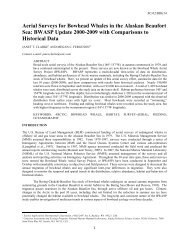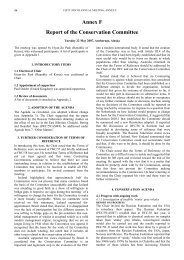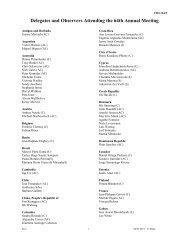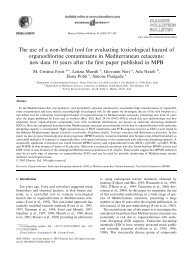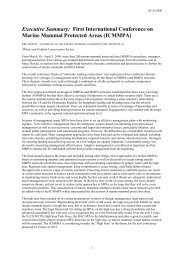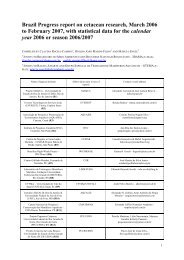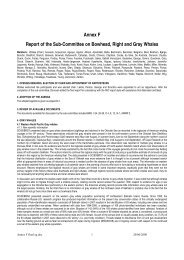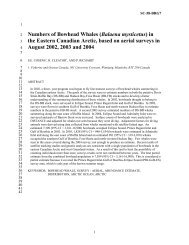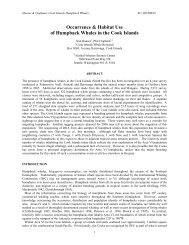bycatch of humpback whales in artisanal fishing gear in ecuador ...
bycatch of humpback whales in artisanal fishing gear in ecuador ...
bycatch of humpback whales in artisanal fishing gear in ecuador ...
Create successful ePaper yourself
Turn your PDF publications into a flip-book with our unique Google optimized e-Paper software.
50% <strong>of</strong> the fleet uses multifilament gillnets <strong>of</strong> 4-5” wide mesh up to 3km <strong>in</strong> length as ma<strong>in</strong> <strong>gear</strong> to<br />
catch large pelagic fish (sharks and billfish) (Martínez et al. 1991).<br />
Here we present new cases <strong>of</strong> <strong>humpback</strong> <strong>whales</strong> entangled <strong>in</strong> <strong>artisanal</strong> gillnets found <strong>of</strong>f Sal<strong>in</strong>as,<br />
Ecuador (2º10’S, 81º’W) (Figure 1). In contrast to previously reported beach<strong>in</strong>gs, these new cases<br />
<strong>in</strong>volved live <strong>whales</strong>. The new approach allowed estimat<strong>in</strong>g the magnitude <strong>of</strong> the total <strong>bycatch</strong> at<br />
tak<strong>in</strong>g <strong>in</strong>to account the survey effort <strong>of</strong> the season.<br />
METHODS<br />
Figure 1. The study area located at Sal<strong>in</strong>as, Ecuador.<br />
Whalewatch<strong>in</strong>g boats have been used as research platform dur<strong>in</strong>g a long-term study <strong>of</strong> the<br />
<strong>humpback</strong> whale <strong>in</strong> Ecuador (see Félix and Haase, 2001a for details). Data analyzed <strong>in</strong> this report<br />
was obta<strong>in</strong>ed dur<strong>in</strong>g the breed<strong>in</strong>g season 2005 (late June-early October). Seven different boats were<br />
used with size rang<strong>in</strong>g between 7 and 15 m <strong>in</strong> length and 10-30 passengers <strong>of</strong> capacity. Usually<br />
boats departed at 9:00 <strong>in</strong> the morn<strong>in</strong>g and last<strong>in</strong>g two or three hours. Occasionally trips were also<br />
made <strong>in</strong> the afternoon. Dur<strong>in</strong>g the trips, <strong>in</strong>formation on survey effort, oceanographic conditions, whale<br />
behaviour, head<strong>in</strong>g, group size and composition was filled out on data forms. As a standard<br />
methodology, <strong>whales</strong> were photographed with a Canon Rebel Digital camera (6.3 megapixels)<br />
equipped with a 70-300mm zoom lens for <strong>in</strong>dividual identification.<br />
RESULTS<br />
Effort<br />
Seventy four trips were made between 27 th June and 1 st October 2005. A total <strong>of</strong> 349 <strong>whales</strong> <strong>in</strong> 148<br />
groups were recorded. Total navigation time was 156 hours, <strong>of</strong> which 59 hours were spent with the<br />
<strong>whales</strong>. The surveyed distance was 2,031km. Table 1 shows the monthly effort deployed through the<br />
season. July and August were the months with the largest effort with trips almost everyday and then<br />
the effort decreased considerably <strong>in</strong> September when tourist activities also decreased.<br />
2




